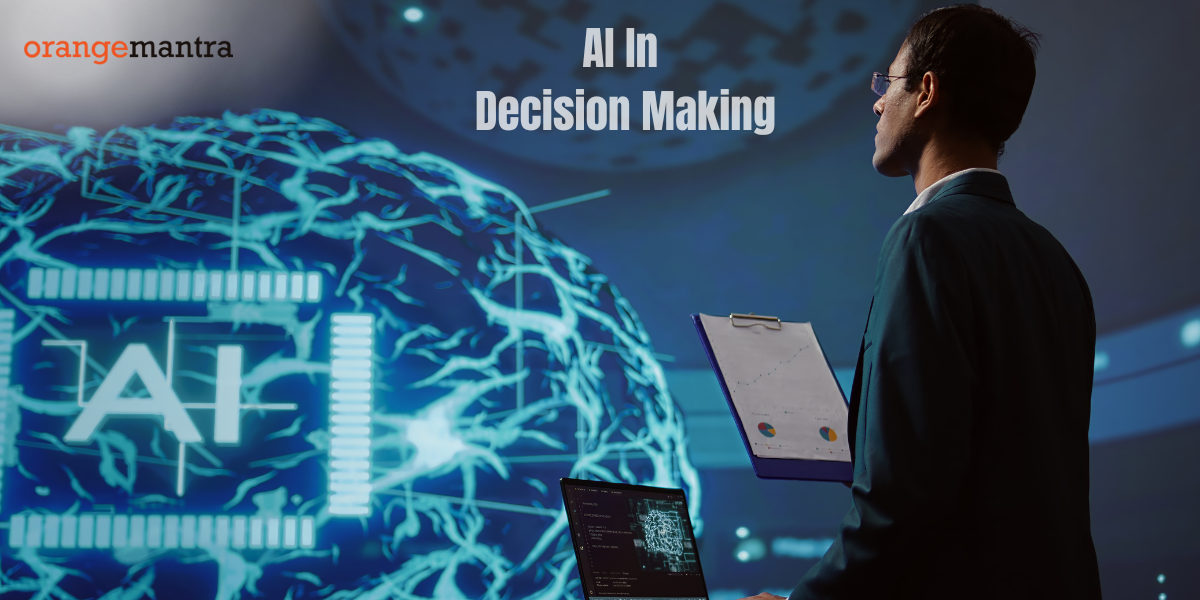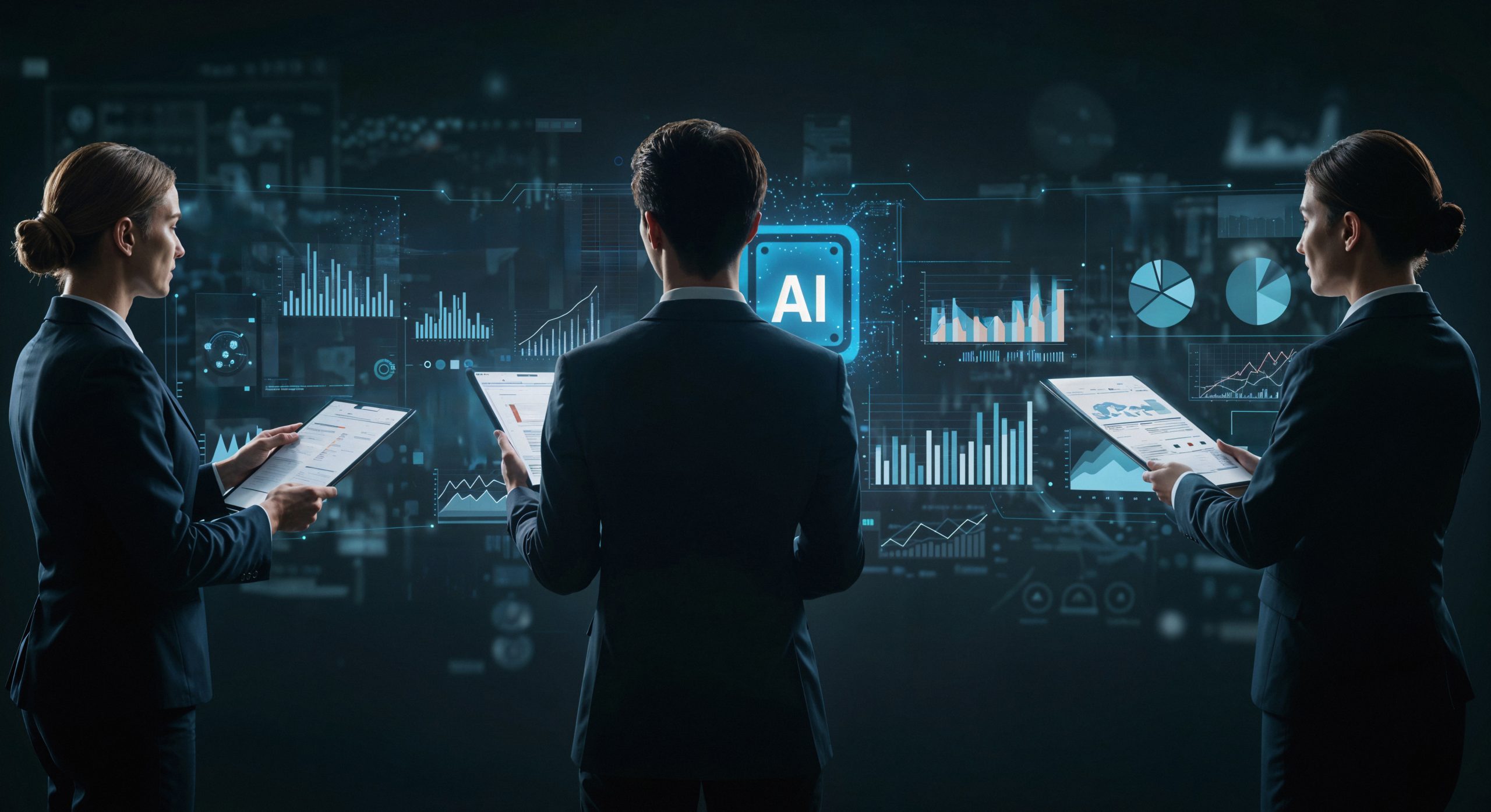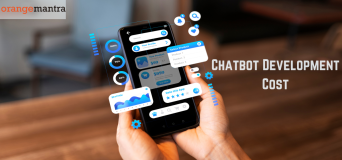
In this blog, you’ll discover how AI in decision making is transforming businesses. From understanding the fundamentals to exploring real-world examples, you’ll learn how AI improves efficiency, reduces risks, and supports smarter strategies.
On average, a human adult makes 35,000 decisions every day, ranging from minor choices like what to eat for breakfast a major life decisions such as choosing a career path.
Similarly, a business owner is expected to make decisions throughout the day, addressing everything – From staff management to financial planning.
While going through large amounts of data can be daunting, making informed decisions will remain a constant challenge. How would you deal with it? Through AI.
In this article, we’ll explore AI in decision-making, why it’s important, and how it can help businesses make faster and smarter choices.
Table of Contents
Understanding the Fundamentals of Decision-Making AI
AI development services analyze large amounts of data, like text and images, to find patterns and predict possible outcomes. Unlike traditional business intelligence tools that report what happened, AI systems explain why it happened.
Machine learning services take AI for decision-making a step further by learning from past experiences and improving its outcomes. This helps industries like retail, finance, and finance businesses to make better decisions.
In fact, IBM states that 42% of businesses have already adopted some form of AI!
On the flipside, traditional human and computer processes require complete and formatted data. These processes rely heavily on human expertise. To make it easier for you to understand, check the comparison table below:
| Aspect | Traditional Decision Making | AI Decision Making |
| Data Processing | Limited to pre-formatted data and human capacity | Easily handle unstructured data |
| Speed | Days or weeks for complete analysis | Minutes or hours for real time data |
| Bias Factor | Subjected to biases and politics | Can be trained to minimize human bias |
| Learning Capacity | Requires manual updates and static processes | Continuous improvement with machine learning |
| Scalability | Limited by human resources | Can grow alongside your business. |
How Artificial Intelligence Helps in Decision Making

AI systems usually combine machine learning algorithms, natural language processing (NLP), and predictive analytics to support your business choices. For B2B businesses, forecast market shifts and understand consumer behavior online.
Here’s a breakdown of the process –
1. Data Ingestion and Processing:
AI systems analyze structured and unstructured data from different sources like CRM, market reports, IoT devices, and financial records.
2. Pattern Recognition:
By using machine learning algorithms and neural networks, AI will identify patterns, anomalies, and correlations. Such data may be overlooked by the human eye.
3. Prediction:
Your AI model will predict the outcomes based on the research it does. It’ll use your data and provide you with recommendations.
4. Continuous Learning:
These AI models can be trained to give more accurate and fair responses. It’ll learn from your input and past experiences to become valuable over time.
Now that you know how it works, you can use AI in business strategy to draft out plans backed by historical data.
5 Benefits of AI for Decision Making
Here’s how you can benefit:
1. Real-Time Responsiveness
AI algorithms analyze complex datasets within minutes, as compared to manual processes. This helps you to make decisions faster and adapt to changing market and customer needs.
2. Reduced Risk
AI plays a crucial role in identifying and mitigating risks and threats. Businesses can leverage AI decision making to minimize risk exposure and identify market fluctuations.
3. Building Consistency
When you combine machine learning algorithms and predefined rules, AI will make consistent decisions. It’ll apply the same logic every time. This consistency will promote fairness, impartiality, and streamlined processes.
4. Improving Efficiency
By eliminating hurdles that manual processes face, artificial intelligence decision making allows decision makers to access relevant data quickly. It also helps in finding loopholes and suggests actions to improve your existing processes.
5. Improve Productivity
Accenture states that large language models (LLM) like GPT-4 can reduce working hours by 40%! Which means that your team can use AI to free up their time and help them work smarter, not harder.
3 Real World AI In Decision Making Examples
From retail to finance, many businesses have benefited from using AI for decision-making. Here are the top 3 examples:
1. Walmart
This retail giant used AI for managing their inventory and ensuring that products were always in stock. By analyzing sales trends, customer preferences, and supply chain dynamics, they used AI to optimize their inventory levels.
This approach helped Walmart make faster and precise decisions. Waste was minimized, and the overall customer experience improved.
2. Netflix
Netflix faced a challenge of retaining subscribers. Deciding on what content to recommend to each user was complex, since their preferences were diverse and each had a different viewing habit.
They used AI-driven recommendation algorithms to analyze customer data, preferences, and viewing habits. These systems helped improve content discovery, allowing their customers to find shows they liked.
3. Deloitte
The healthcare industry faced a challenge in diagnostic accuracy, treatment personalization, and workflow inefficiencies. Since Deloitte is a pioneer in providing AI solutions to augment health decisions rather than replace clinicians.
AI tools such as advanced image analysis and predictive analysis provide personalized recommendations and remote treatments. Patients were able to find the best providers through Deloitte’s “Care Finder,” which used machine learning algorithms and natural language processing.
Real Implementation Insight Of AI Decision Making
A prominent law firm in the US was overwhelmed with a huge amount of paperwork. Lawyers frequently spend time on administrative tasks. Our team stepped in to integrate AI in their workflow, which automated these tasks and enhanced their decision-making.
However, we had to be careful while using AI as they dealt with confidential data, and we couldn’t violate their ethical rules. The AI solution that we developed for them helped them by –
- 42% faster in contract drafting
- 50% reduction in research time and making decisions faster
- 92% accuracy in meeting summaries
How to Adopt AI Decision Making
AI and decision making go hand and hand. Adopting this in your business will be an important step to simplify your work. Here’s how you can convince your team:
1. Building Trust
Trust is the foundation for a successful AI implementation. AI systems must be transparent and easy to use so that your tech and non-tech teams. When AI algorithms provide insights on how they came up with the conclusion, it becomes easier for your team to use AI in business strategy.
2. Access for Wide-Scale Adoption
Cloud-based AI services and pre-trained models allow businesses to deploy and scale AI without much experience. As AI becomes more accessible, AI for decision-making has helped industries and employees to become empowered.
3. Seamless Integration
Effective integration includes working alongside domain experts and end users to ensure AI solutions cater to business needs. By prioritizing a smooth implementation process, AI decision-making will allow individuals to make informed and data-driven decisions.
How to Implement AI Decision Making in B2B Organizations
If you’re considering implementing AI for decision-making, and not sure how to start? Here’s a 5-step process that you can follow:
1. Start with Pilot Projects
Begin with high-impact, data-intensive decisions that have measurable outcomes. Successful pilots build confidence and momentum for broader AI adoption.
2. Build Data Foundation
Invest in data quality, integration systems, and governance before scaling AI. Ensure robust cloud infrastructure, processing capabilities, and security protocols are in place.
3. Develop AI Skills
Train your teams on AI capabilities and limitations through targeted programs and strategic hiring. Foster collaboration between AI experts and business specialists.
4. Establish Governance
Create policies for data privacy, algorithmic fairness, and transparency. Define which decisions can be automated versus requiring human oversight. Implement regular audits.
5. Manage Change Effectively
Focus on workflow redesign and employee support. Communicate how AI augments rather than replaces human capabilities. Address concerns through transparent training.
3 Challenges in AI Decision Making
Although artificial intelligence decision making has its advantages, it comes with a price. Here are the top 3 challenges you should be aware of:
1. Bias
Even though AI models can learn from past experiences, it is still prone to discriminating against certain groups of people. You’ll need to regularly monitor the outcomes AI systems provide to ensure fairness amongst a diverse range of clients.
2. Black Box
Sometimes, the explanations AI provides may be complex for us humans to understand. Many businesses are still reluctant to fully trust the outcomes AI gives. Developing an explainable AI system that can articulate their reasoning in simple language is an ongoing priority for businesses.
Example: The Johns Hopkins TREWS system detects sepsis and explains its recommendations to doctors, building trust through transparency.
3. Data Quality
Many businesses, especially startups, struggle with fragmented data and inconsistent formatting. Due to this, AI wouldn’t be able to help with sales or decode customer behavior online.
Can AI Replace Humans in Decision Making?
No, it cannot. A human touch is needed to make the final decision and think from an emotional and strategic angle. While Amazon’s recommendation algorithm fully runs on AI, the final decision is with the customers.
While AI algorithms can make decisions on ethics and social norms, the final call will always remain with humans and will be held accountable.
For more information read: AI vs Human Intelligence
Wrapping Up
In short, AI in decision-making has played a crucial role in helping businesses simplify their work. However, you need to be mindful before you implement it, as it comes with challenges of its own.
While AI can assist you in making decisions, it cannot replace humans. Humans will be required to make the final decision, ensuring the outcomes it provides are ethical and fair for everyone.
So, if you want to outshine your competitors, it’s important to include AI in your business’s DNA and have a solid grasp of AI fundamentals. If you’re considering using AI and want to know the estimated costs of AI, you’ll find this article useful.
Frequently Asked Questions
Q1. Can AI make decisions?
Yes, it can! AI relies on structured data such as reports to identify customer behavior online and forecast market trends. The more structured your data is, the more accurate the outcome will be.
Q2. What’s the main advantage of AI decision making?
It analyzes vast amounts of data quickly and accurately, identifies patterns and insights that might be overlooked by humans.
Q3. How is AI transforming businesses with decision making?
Businesses in all industries can take advantage of AI to predict trends before they emerge and personalize customer experience in real time.
Q4. What challenges do businesses face by using AI for decision making?
Bias, lack of transparency, and lack of data are some of the biggest challenges businesses face. If not trained properly, AI can discriminate against certain groups. And without proper reasoning, businesses find it tough to trust AI.
Q5. How good is AI in decision-making?
In many cases, AI surpasses humans since it’s faster and more accurate. But it’s important to keep in mind that it won’t replace human beings. A human touch is mandatory to cross-check the outcomes AI gives and make decisions from a strategic mind.




